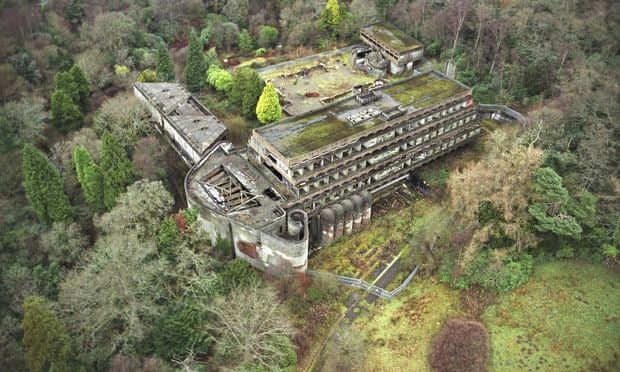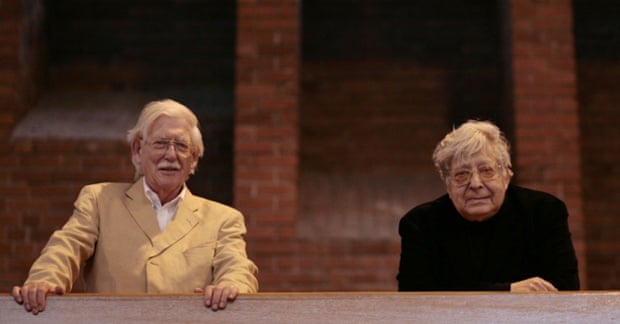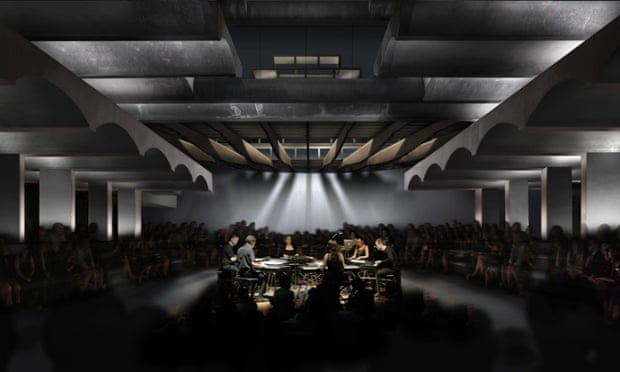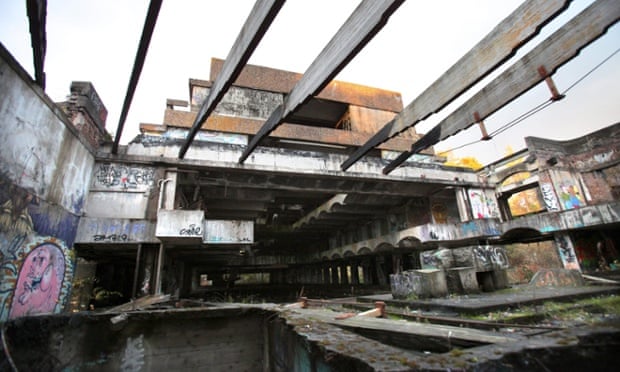St Peter’s seminary – a second coming for Scotland’s modernist masterpiece?
Scotland’s most significant modernist building, St Peter’s seminary near Glasgow – built in 1966 and abandoned in 1980 – lies in ruins. But plans are afoot to resurrect this battered masterpiece and give it a second, secular life

There is no place like it, on these islands, for the mutual battery of multiple forces, for the thumping, pummelling and attrition of creation and destruction, the incessant beating of weather, vandals and arson against rocks of obstinate architecture. It is like watching medieval knights club each other to death yet stay standing. It is a mud-wrestle of culture and nature. Only the scorched, rusticated carcass of John Vanbrugh’s Seaton Delaval Hall in Northumberland can come close.
It is also serene. The seminary of St Peter’s Kilmahew, near Cardross, near Glasgow, was intended for making tender young men into priests, a role it performed for 14 years after it opened in 1966. Canon Jim Foley, a veteran of St Peter’s, has written of “the elusive wonder and beauty” of the lighting effects in the sanctuary. You can still detect moments of grace in a fragment of handrail. There is still poise in its balance of forces, in the way its crowning concrete ziggurat comes to earth on columns that look too slight for the task. Its basilica, caked in graffiti, but with openings to the sky and trees, alternately radiant and sombre in the changeable weather, remains spiritual.
It is probably not surprising that it should have attracted the attention of Angus Farquhar, a man whose 1980s band of five percussionists, Test Dept., made instruments of scrap metal and old machines, and liked to perform in London railway arches and borrowed train stations. Farquhar is now creative director of the Glasgow-based NVA, an organisation he set up to create large-scale public artworks and events, usually in dramatic locations. He wants to make the seminary into an “international venue for public art and knowledge exchange”, by which he means concerts, art events and education projects. This sounds vague and optimistic, but NVA have a convincing record of attracting people to unlikely places.
He has recruited the architects Avanti and Nord and the landscape architects ERZ to design its new incarnation, and has set about removing the twin evils of asbestos and rhododendron from the building and its grounds. He has persuaded the Heritage Lottery Fund and other public and private donors to contribute £5m towards rescuing the building and the Catholic Archdiocese of Glasgow to hand over their modern ruin for the purpose. He needs £2m more.

“I could find you 10 people today,” he says, “within 10 square miles of here who would willingly put a bomb under it. There is a sense of it being a netherworld where dark things happen.” At the same time people from Brazil and Australia come to visit, some for the architecture, some connoisseurs of the high-class graffiti, some “people in their 60s and 70s entering illegally so they can show their grandchildren.”
It has also been called the best 20th-century building in Scotland. It was the work of the long-established firm of Gillespie Kidd and Coia, whose principal, Jack Coia, was, reassuringly for the church, of Italian Catholic origin. It was, however, designed by two young members of his staff, Isi Metzstein and Andy MacMillan, atheists of German Jewish and Scottish Presbyterian backgrounds. When later asked how he could design this seminary, as well as several churches, Metzstein said something to the effect that you don’t have to be a cow to design cowsheds.

Under Coia’s protection Metzstein and MacMillan forged a Scottish modernism unlike anything else, anywhere. They have debts to Le Corbusier and Frank Lloyd Wright, but also to the massive construction of Scottish castles, the iron and stone of industrial Glasgow, and the emotional and physical range of Charles Rennie Mackintosh’s Glasgow School of Art, which runs from heavy roughcast walls to delicate metalwork and stained glass. Their work was stormy, passionate and not always waterproof, and MacMillan didn’t help himself when asked why his buildings leaked: “I think it’s because we had to build them outside.” After they completed Robinson College Cambridge in 1980 the practice petered out, with Metzstein and MacMillan only in their early 50s. From then until their deaths in 2012 and 2014, they were influential and inspiring teachers of architecture.

“People were looking for thinner and thinner walls,” they said of post-war modernism, but “we cherished and revelled in the idea of thickness of building.” They liked the “wonderful geometric oddities” of thick-walled castles, “exploited the depth of walls for manipulating light”, and spoke of “the delight of the reveal”. All of which was present in St Peter’s, where the influence of Le Corbusier’s monastery of La Tourette combines with their Scottish inspirations. It has, or had, ambitious cantilevers and generous openings to nature, ranks of silo-like hemi-cylinders, industrial steelwork, spare timber beams supporting the lantern that admitted the light that enthralled Canon Foley.
It was built around a 19th-century baronial house (demolished after a fire in 1995) in a wooded landscape sloping up from the Clyde that is part ancient forest, part Victorian invention, with exotic species introduced among the indigenous. The building has the elements of traditional religious buildings – cloister, chapel, refectory, cells – but rearranged over multiple levels in unexpected ways, alternately enclosing and opening up to its surroundings. Water flows around it in streams and channels and, since the destruction of most of its roof, down it and through it.

It never quite worked as hoped. It was hard to attract the intended numbers of novitiates. The junctions of its ambitious geometries did not prove equal to the temperamental Atlantic weather, nor walls of single glazing to the cold. The specification of hard-to-replace lightbulbs from Denmark meant that students would take still-functioning bulbs to meals with them, for fear they would be un-Christianly pinched. Before the building was even finished the Second Vatican Council decided it was important to train priests in the communities they would serve, rather than on remote hillsides like this. It closed in 1980 and served some time as a drugs rehabilitation centre, but for most of its life has been the Battersea power station of Argyll and Bute, a wreck as thoroughly beaten up as a building can be, outside a war zone. It has been the object of hopeful proposals – a boutique hotel, for example – that came to nothing.
Farquhar and his team are not proposing the complete restoration of the original design, but its stabilisation and restitution in various degrees of ruined-ness. This is both practical and true to the tempestuous spirit of the place. “Our role is not to make people like it,” says Farquhar. “That would be the least interesting thing you could do. This is a contested site, and we want to work with that.” “Everyone has acknowledged,” he also says, “that this is its last chance.”



沒有留言:
張貼留言